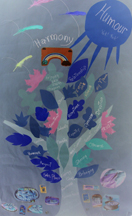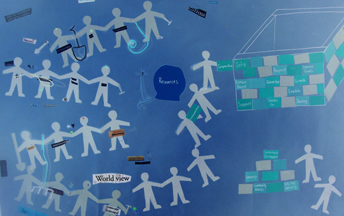The Learning Circles Project |
||
| Health Action Theatre by Seniors
(HATS) by Tracey Mollins |
||
Empowering Seniors at Ossington and Dundas in Downtown TorontoI never sat on a school bench and today. I was teaching a university
class. At a committee meeting at St. Christopher House, a group of seniors said that they wanted to work on the issue of elder abuse and the Elder Abuse Peer Support Project was born. One of the things this group did was share stories that they had heard in the community. The Elder Abuse group started to do storytelling with other senior’s groups and Portuguese groups; this was a very new thing for these groups. The Elder Abuse group seniors found that some people could read and some could not so the stories were spoken or were read aloud. The members of the Elder Abuse group knew that they wanted to become popular educators. They began to look for a tool that would allow people to participate equally regardless of their level of education or what language they spoke. They had started using images and role-plays to illustrate the stories. By 1997, they had started to experiment with theatre and decided to look at different theatre styles to see what could be adapted to their needs. And then … synchronicity. Someone from the Ripple Effect Festival called and proposed doing a Theatre of the Oppressed (TOO)* workshop at St. Christopher House. The group was excited by the technique but saw that the use of language was a barrier to them working with multilingual groups who may not share a common spoken language. The troupe currently has Vietnamese-speaking and Portuguese-speaking members. Some share English as a common language and some do not. They perform for a range of audiences whose members speak and understand a range of languages. The group never assumes a certain level of English comprehension or reading ability. The troupe decided to combine the techniques of TOO and pantomime and founded the Health Action Theatre by Seniors (HATS). They use interpreters to help with the discussions, but the scenes are acted out without words. The HATS process of creating plays is a collective one. No one has ownership of the play. Each actor owns the character he or she is playing, but not the story. When actors change roles, they can play the character differently as long as they show what the character is about. The troupe members create a space that is safe and discrimination free for their work. They want their own members and the audiences to engage in critical thinking and conflict resolution processes. They understand that people need to be free to engage and to speak so they must create the conditions for that to happen. It was not always this way. In the beginning, in trying to create an egalitarian, democratic process they decided there would be no director. At first, they felt a vacuum and everybody tried to fill the director role. Troupe members felt that they were being bossed by other members. They made a rule, no directing. The troupe facilitator, Isabel Palmar, watches for things that will change the concept and then works with the actors to recapture the concept. There is always much care and concern about making everything accessible to as many people as possible. This principle runs deeply through the work of this group. They apply it in all aspects of what they do, from how they plan and perform the plays to how they make the website interactive. I found the example of how they made the website interactive very interesting. Palmar was concerned that people entering keywords would spell them incorrectly. She went to an English-as-a-second-language class and asked the instructor to find out how the students might spell the keywords if they were guessing and sounding out English spelling. The instructor used the words in a dictation, gave the dictation results to Palmar and she entered all these variations as key words.
The HATS method calls for short plays that are mimed. The audience is encouraged to change how the actors have dealt with an issue in their play, and to replace an actor so that the play can be performed again with different endings. People of diverse cultures, languages and literacy levels are able to engage in the exploration of critical issues, share their knowledge and experience the power of shared problem-solving. This can be a little chaotic but much growth happens at the edges of chaos. Once the process of replaying the scenes starts, the whole audience becomes quickly and deeply engaged. They watch the replayed scene, analyze and critique the new outcome, and replay it in response to the new information and understanding. This continues until the audience is satisfied they have reached the best possible outcome. Often there is a discussion about how the barriers to the best outcome are systemic so the group tries for the best possible outcome in the circumstances and thinks about how to achieve or advocate for systemic change so that the best outcome is possible in the long term. The HATS troupe finds that not using words not only makes the work more accessible, but also allows people to interpret a scene based on their own experience. Sometimes the stories that come from the audience seem to have nothing to do with the scene. These are important stories. The actors from the HATS troupe do not impose their stories; they work with the stories that come up. For example, there is a scene about home repair fraud where, after a contractor pressures a senior to sign a contract, her son is very upset and mother and son have a heated discussion. Some see it as fraud and that the son is trying to protect his mother from crooked business people. Others see that the house needs to be fixed and that the son is upset because he wants his mother to sell her house and not spend any more money on it. The troupe has to be prepared to go with either story. This requires a lot of preparation. Both stories will lead to a discussion of rights. The joker, or facilitator, helps with this. The joker acts as a mediator between the reality of the workshop and the reality of the world the participants live in. The joker moves the discussion from looking at individual situations to looking at systems. As you can see from the story of HATS, the troupe members are responsible for the foundation and direction of this group. They continue to direct the group by deciding what topics will be addressed and how they will address them. Palmar acts as coordinator and fundraiser. She listens to the group and then looks for funding for what they want to do. She says that sometimes the topics are determined by the funding. In the first year, the troupe had elder abuse funding. Palmar sought this funding in response to the group’s original goals and vision. They continue to get $10,000 a year from the elder abuse program at Doctor’s Hospital for this work. In the second and third year they got funding for fraud prevention and health education. In these cases, the topic was determined by the funding but the stories came from the troupe members. Sometimes it is a little of both. During its first three-year cycle, HATS was sponsored by GlaxoSmithKline through the SHARE Awards Program. The SHARE Awards are administered by the University of Pennsylvania's Institute on Aging and are awarded to community-based organizations that provide culturally-sensitive health care and/or access to health care services. HATS used the SHARE funding to develop a website where they could document their work and make their manual accessible and available to other groups. They wanted the website to be one way they meet their goal of creating a ripple effect - the program's ability to spread beyond its immediate audience as others adopt and replicate the methodology. They thought, in order to meet the requirements for the SHARE funding, they would have to have a new play for the website. When the SHARE people saw the plays, they liked the plays so much that they picked one for the website. The requirements were renegotiated so that HATS did not have to create a new play but instead attach worksheets about health. Through their work with UPENN, HATS has traveled and will travel to universities to do presentations of their work and about their work - hence the opening quote. Sometimes the troupe sees a need and Palmar writes it into the funding proposal. The troupe has been discussing their observation that women participate much differently in HATS than men do and that women seem to be more empowered by the process. This year they have included men’s empowerment and participation as one of their outcomes. They will have to look at their processes and see how current practices are a barrier to men’s participation and how they can change the way they work to be more inclusive. Palmar says this will be a challenge, but including this in the funding proposal pushes them to meet this goal. Sometimes Palmar sees the need and approaches the troupe about it. At the St. Christopher House Elderly Person’s Centre (EPC), several groups operate under different leadership models. The EPC Member’s Council acts as an advisory board and is moving towards a more self-directed structure; the Portuguese Women’s group and the Society of Disabled Portuguese People have boards and are mostly self-directed; and HATS operates with staff support. Palmar says that right now HATS is not working on its own and she acts as organizer, fundraiser and convener. She knows that they could take on more of this work but that they are very busy so she has been doing it. For the next three years, these four groups will participate in a Trillium Foundation-funded project called Group Effectiveness and Leadership (GEL). The groups will learn about each other’s operating structures and strengthen those structures. Participating in this project also guarantees that these groups will be supported by the agency for its three-year duration; the outcome of this project is that all four groups strengthen their structures and move to a self-directed model of leadership so all four must exist for the three years to maintain the funding. Sometimes a funder approaches HATS. Robert Luke from the Community Learning Network was working on a five-year patient education and professional development project when he saw the HATS website. He asked them to do a play about going to the doctor. He liked the play and saw that it fit the goals of the CLN project. He has asked if HATS would be willing to do this again. This year, HATS will be carrying the ripple effect to seniors and youth in Parkdale. There has been a request from the community that HATS share their methodology with seniors and youth in Parkdale. They will teach them how to do TOO, share their experiences as theatre producers and with the self-publishing tools developed through their work on the website. The Parkdale youth and seniors will then share experiences and knowledge to create their own plays and website. * The HATS method originated from the Theatre of the Oppressed, a unique and revolutionary educational theatre method. The Theatre of the Oppressed was developed by the Brazilian theatre director Augusto Boal during the 1950's and 1960's and it quickly grew into a movement which spread all over the world. Boal's technique was based on the teachings of the famous popular educator Paulo Freire. Both have been highly influential in the development of the politics of liberation. Boal maintained that participatory theatre could be utilized as a powerful tool for transforming monologue into dialogue, consequently overcoming oppression. |
||

